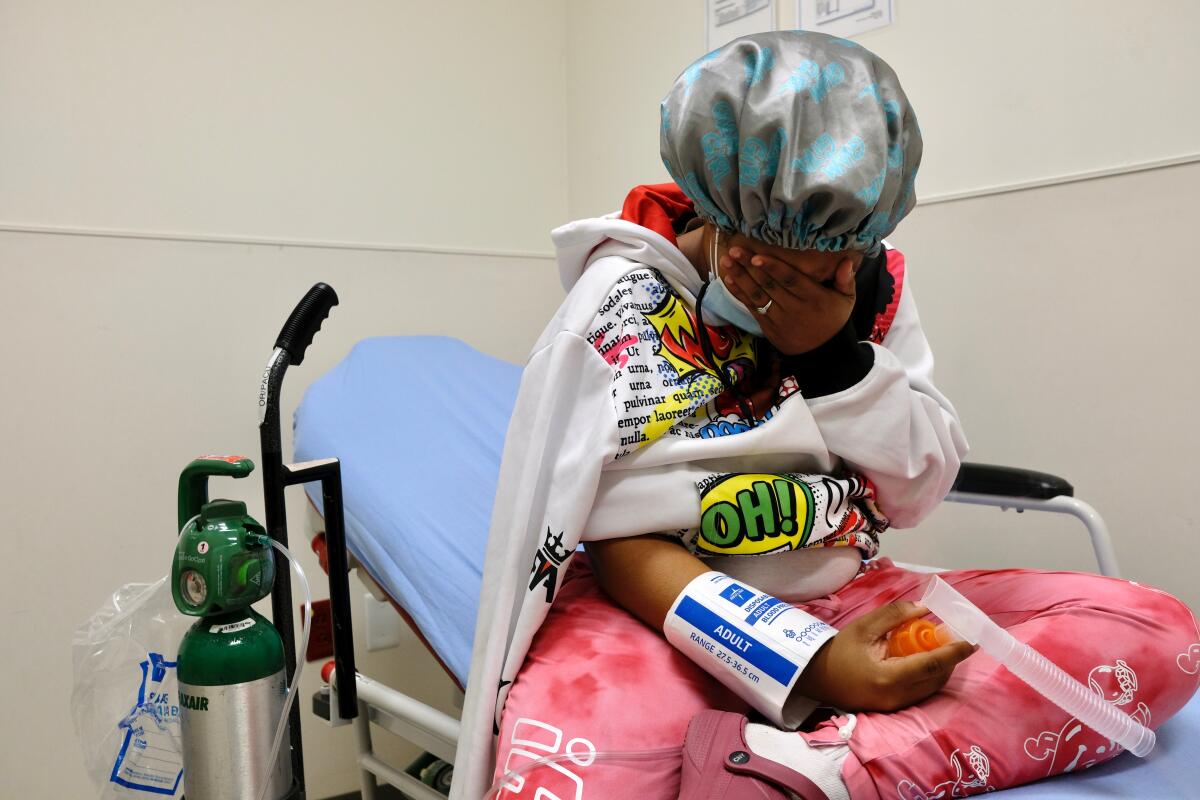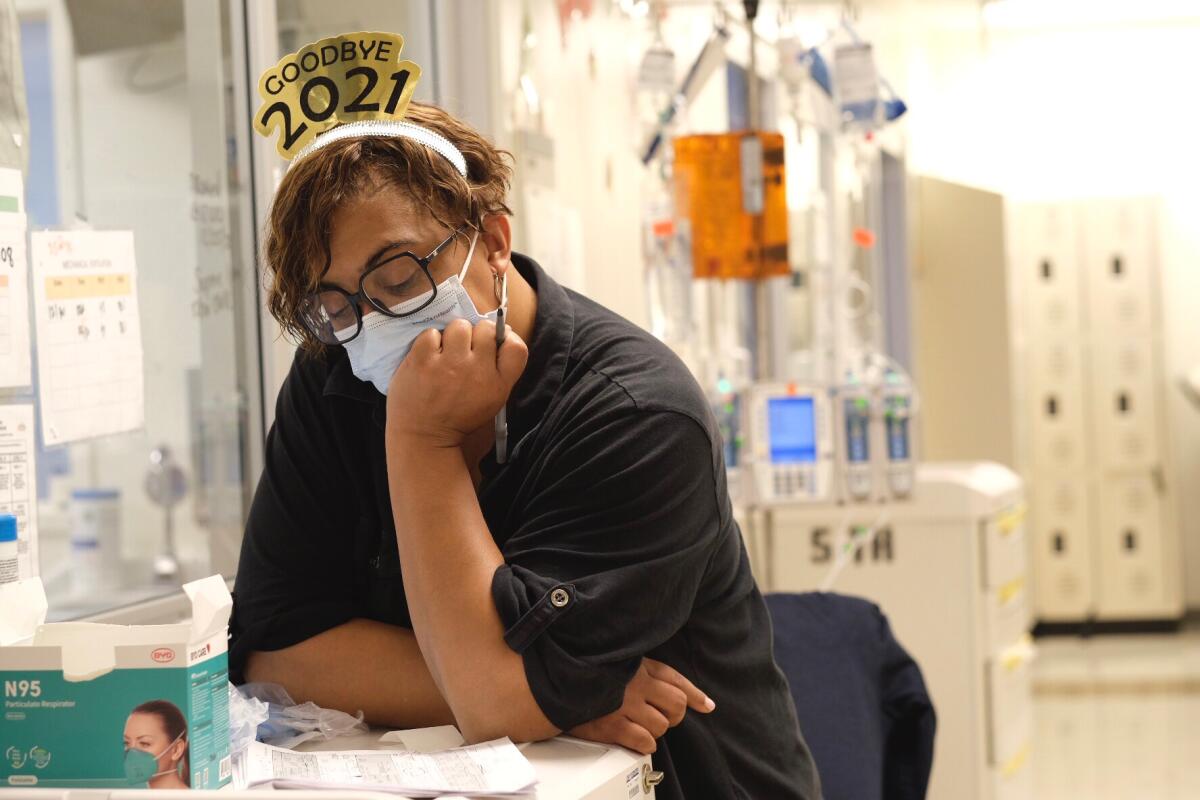Younger adults driving coronavirus surge in Southern California

Southern California entered 2022 in the midst of a rapid upswing in coronavirus cases from the Omicron variant, with adults ages 18 to 49 transmitting the virus at a high rate and officials urging the public to curtail holiday weekend gatherings to help slow the surge.
Los Angeles County recorded more than 27,000 new cases on the final day of 2021, far above last winter’s peak average of 16,000 cases a day. Nearly 1 in 4 people who are being tested are positive for a coronavirus infection, officials said.
The daily totals of new coronavirus cases are doubling every two days. On Tuesday, 9,473 cases were reported; Wednesday, 16,510; Thursday, 20,198; and Friday, 27,091. The positive test rate for the most recent seven-day period was 22.4%, double what it was for the week that ended on Christmas, when it was 11.4%.

More than 70% of coronavirus cases in Los Angeles County from Dec. 22 to Dec. 28 were among adults younger than 50. During last winter’s surge, adults in that age range made up 55% of coronavirus cases. Case rates per 100,000 people have increased the fastest in that age group.
Rates among the youngest adults — those 18 to 29 — are more than eight times higher than they were one month ago. And among adults in their 30s and 40s, cases are six times as high.
“Many of the people in this age group are important members of our labor force,” Los Angeles County Public Health Director Barbara Ferrer said this week.
“And these are also folks that are very likely to be out and about for recreation,” Ferrer added. “Often this age group doesn’t experience the worst consequences of increased transmission. And sometimes that’s made it more difficult for individuals to stay attentive to the need to be vigilant about adhering to all of the public health safety measures.”
Case rates have doubled for children ages 5 to 11 and tripled for adults ages 65 to 79.
In Orange County, it’s adults 18 to 44 who are driving coronavirus transmission, said Dr. Regina Chinsio-Kwong, a deputy health officer.
The state’s COVID-19 model estimates that in Southern California and the San Francisco Bay Area, every infected person is on average transmitting the virus to 1.5 other people — meaning the spread of the virus is increasing rapidly. The rates are even higher in L.A., Orange and San Francisco counties, where the number is estimated to be 1.7.
Coronavirus case rates are rising among people of all vaccination statuses, but unvaccinated people are still the most likely to test positive. For the week that ended Dec. 18, 375 of every 100,000 unvaccinated L.A. County residents tested positive. The rate for those who are vaccinated but have not gotten a booster shot was 173 per 100,000. The rate among boosted residents was 65 per 100,000.
Despite the ballooning infection numbers, far fewer patients have been hospitalized with COVID-19 so far in this fifth surge than during the last two surges.
Health officials have voiced optimism that symptoms in cases linked to Omicron are less severe than those from earlier variants. That may be in part because although Omicron appears to be more infectious to the airways, it appears to be less infectious to lung tissue, where infections contribute to respiratory problems and death.
It’s also likely that disease severity is lower overall because so many people have been vaccinated. During last winter’s surge, very few people had been vaccinated because of limited supply.
Still, the huge increases in new coronavirus cases have health officials worried that hospitals — especially in areas with low vaccination rates — may be slammed by a crush of patients if transmission remains this high and the virus is able to find a large number of unvaccinated people. Those who have not received a single shot remain at highest risk of severe illness from COVID-19.
L.A. County’s COVID-19 hospitalizations have risen 72% since Dec. 23, when 850 people were hospitalized; the most recent tally available showed the number rising to 1,464 as of Thursday. Still, that number is one-fifth of the tally a year earlier, when L.A. County had 7,628 coronavirus-positive people in its hospitals. That was close to the pandemic’s all-time high of 8,098 COVID-19 hospitalized patients, recorded Jan. 5, a time when hospital morgues were overflowing.
Across California, 5,433 COVID-19 patients were hospitalized Thursday, a 48% jump from a week earlier. But, again, the state’s hospital tally was a fraction of what it was a year ago, when 20,640 people with COVID-19 were in hospitals statewide, nearing the all-time peak of 21,938 recorded Jan. 6.
COVID-19 hospitalizations have risen most dramatically in the last month in Southern California and the San Francisco Bay Area, where the tallies have roughly doubled, and they have increased notably in the Greater Sacramento area, where the rate is up about 30%.
Southern California now has the worst COVID-19 hospitalization rate in the state.
For every 100,000 residents, Southern California is reporting 16 hospitalized COVID-19 patients; the Greater Sacramento and San Joaquin Valley areas, 14; rural Northern California, 12; and the Bay Area, 7. A rate of 5 or higher is considered concerning.
Within Southern California, the Inland Empire has among the worst rates, with 27 hospitalizations per 100,000 residents in San Bernardino County and 19 in Riverside County. San Diego County has a rate of 15 per 100,000; L.A. and Orange counties, 14; and Ventura County, 12.
Ferrer said that all efforts need to focus on keeping hospitals from being overwhelmed.
“Since most people in our hospitals with serious illness from COVID are unvaccinated, those not yet vaccinated or boosted need to please stay away from others as much as possible to avoid getting infected or infecting others,” she said in a statement Friday.
The Omicron variant is believed to be two to four times as contagious as the previously dominant Delta variant. People who are eligible for booster shots but haven’t yet received them are at increased risk for infection.
“Data from South Africa and the United Kingdom demonstrate that vaccine effectiveness against infection for two doses of an mRNA vaccine is approximately 35%. A COVID-19 vaccine booster dose restores vaccine effectiveness against infection to 75%,” the U.S. Centers for Disease Control and Prevention said in a statement.
Recent data in L.A. County have shown an increase in healthcare workers being infected with the coronavirus, which is expected to “create stress at our healthcare systems,” Ferrer said.
L.A. County residents 80 and older have “now seen the highest increase in hospitalizations over the past two weeks” compared with other age groups, Ferrer said. In Orange County, 87% of people hospitalized with COVID-19 are unvaccinated.
Daily tallies of new pediatric COVID-19 hospital admissions across L.A. County were zero to one in early December, and have climbed to about five to seven per day more recently, Ferrer said.
“This is an increase to be sure, but I want to note, it’s still a relatively small overall number,” Ferrer said.
With overall cases skyrocketing, state and local officials have indicated no need for new orders closing certain businesses or mandating people to stay at home, but they have looked at bolstering requirements in certain settings for vaccinations or negative coronavirus tests.
On Friday, the California Department of Public Health announced a new order to require those at indoor events with 500 or more attendees to show either proof of full vaccination or a recent negative test to enter. The order will go into effect Jan. 15. Currently, only indoor events with 1,000 or more attendees are subject to the requirement.
The state also announced a tightening of vaccination-and-testing requirements for people wanting to visit nursing home residents. Starting Jan. 7, visitors wanting to make indoor visits must be up to date on their COVID-19 vaccinations, including a booster if they are eligible, and provide evidence of a recent negative coronavirus test.
A visitor who hasn’t met those requirements can still meet with nursing home residents at the facility but would need to meet them outdoors and would still need to provide proof of a recent negative coronavirus test.
If a resident can’t leave their room and meet with a guest outdoors, the visit can take place indoors for visitors who can’t provide vaccine verification or a negative test, but it can’t take place in a common area or the resident’s room if a roommate is present. The order exempts guests rushing to see a patient who is in critical condition and may be imminently dying.
On Thursday, California issued new recommendations for isolation of people infected with the virus, guidance that is stricter than that made earlier in the week by the CDC.
California recommends that asymptomatic, coronavirus-infected people can exit isolation after the fifth day following a positive test, but only if they get a negative test result.
By contrast, the CDC’s recommendations don’t ask for a follow-up negative test; the agency recommends that those ending isolation continue wearing a mask around others for five additional days.
“The days ahead will be extraordinarily challenging for all of us as we face extraordinarily high case numbers reflecting widespread transmission of the virus,” Ferrer said. “In order to make sure that people are able to work and attend school, we all need to act responsibly.”
More to Read
Sign up for Essential California
The most important California stories and recommendations in your inbox every morning.
You may occasionally receive promotional content from the Los Angeles Times.












